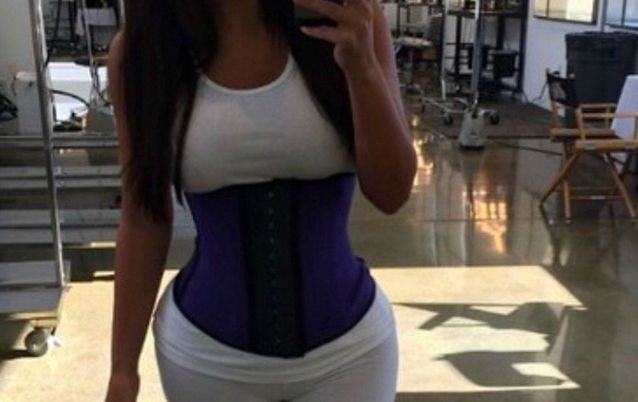KIM Kardashian is always waist-training, according to her Instagram account. In a May 2015 selfie, she wore an undershirt, leggings and a tight black tube around her waist.
The purpose of the shot: promoting the band around her midsection, a so-called waist trainer from Miami-based company Waist Gang Society, to her 62-million followers.
Waist-trainer makers claim their products reduce waistlines, and one such celebrity social media post can send sales soaring for several days, explains Waist Gang Society’s owner, who goes by the single name Premadonna.
Forms of waist training have been around for centuries — the word "corset" dates back to 1300 — and the goal has remained the same: make a woman’s waist shrink, or at least appear to shrink, using tight fabric around the midsection. Some of these undergarments include boning, for stiffness;others are made of more flexible materials such as latex. Some zip, some tie, and others, such as Kardashian’s, fasten through hook-and-eye closings.
In the past two years, waist trainers have surged in popularity. According to Google Trends, searches for "waist trainer" began growing in August 2013 and maintained an upward trajectory, peaking in March last year.
Although Google advertisements can help sales, several waist-trainer companies say sales are most heavily affected by Instagram, where the hashtags "waist trainer" and "waist training" have been used more than a million times. Such posts typically feature a woman wearing the trainer or showing off the results.
Brands deem Instagram celebrities with scores of followers to have cultural influence, and companies pay them handsomely to promote their products.
Blac Chyna, a model with 5.2-million followers, reportedly charges $2,000 per post, and promoted a waist trainer from Instacurve during the holiday season. Reality show stars commonly use their Instagram accounts this way, but so do more prominent celebrities:Vogue cover model Gigi Hadid (14.2-million followers) has promoted Maybelline, a company she models for, and pop star Britney Spears (8.5-million followers) has extolled the virtues of Eos lip balm.
"Celebrity influence through social media has been the primary factor" for sales growth, says Ruben Soto, CEO of Chicago-based waist-trainer company Hourglass Angel.
The company’s sales have nearly tripled in the past two years, Soto says. "It became acceptable to post selfies on Instagram wearing these products after celebrities wore them. They opened the door."
Waist Gang, which has more than 333,000 Instagram followers, says sales have been "increasing steadily over the past two years".
Noticing the success of companies such as Hourglass Angel and Waist Gang Society, Atik Motiwala, a former digital marketer based in Florida, started his own waist-trainer enterprise, Hourglass Express, about a year ago. "We saw the popularity, and we decided to give it a shot," he says. "I had a family member who was trying to purchase a waist trainer, and they were out of stock. I said, ‘If they’re sold out, that’s a good sign’."
Motiwala promoted Hourglass Express through Facebook and Google advertisements, but is about to expand into Instagram endorsements. Thus far, Hourglass Express hasn’t worked with any "official Instagram celebrities", says Motiwala, but he is negotiating pay-per-post deals with several users, whom he expects to pay$1,000-$2,000 per endorsement.
Royal Lioness, a Pennsylvania-based waist-training company launched last June, selling a lower-priced trainer, also woos Instagram celebrities, but its CEO, Brian Nguah, says he provides them products, not cash.
He explains: "We don’t work with them, but we reach out to them. We show them what we are doing. We ask them to try it out, show them our (fitness) routines, and if they like it, they can talk about us. If not, that’s understandable, and they can still keep (the trainer)."
Waist-trainer companies insist their products make customers slim down, spurring repeat orders. "Once you see results, you size down," says Motiwala.
A third of Royal Lioness customers makea second purchase within 30 days, Nguah says.
There’s little scientific evidence, though, that the weight-loss effects of waist trainers are real.
"What you see is just temporary — while you’re wearing it. It’s just squeezing in the fat or excess tissue," says Dr Margarita Rohr, an internist at New York University’s Joan H Tisch Center for Women’s Health. "As soon as you remove it, the fat goes back to where it was. You’re not going to see any permanent results."
Dr Rohr also warns that the products can cause skin irritation and artery constriction.
Little to no research has been conducted about the side effects of wearing a waist trainer for long periods of time, says Dr Sandra Adamson Fryhofer, an internal medicine expert in Atlanta, but physicians worry that frequent waist-trainer users could be squeezing and displacing organs, putting pressure on the lungs, forcing acid into the oesophagus, and causing heartburn.
Most companies emphasise some degree of caution when using the trainers. The Waist Gang website suggests users "begin by wearing the corset two to four hours per day", and add time "until you are able to wear the corset throughout the entire day".
For the average user, even half the day can be a lofty goal. Krista Grubb, a sales consultant who purchased Premadonna’s trainer, says she could wear the trainer for up to five hours, but now reserves it primarily for evenings out.
For those pursuing a more traditional path to slimming down — diet and exercise — there are custom trainers for working out. It’s as common to see an image of a trainer-clad woman at the gym as in a gown on Instagram.
These workout-specific trainers are disconcerting to physicians, who warn that constricting the torso while exercising could limit oxygen intake.
"It actually hinders your workout," says Dr Rohr. "You need to be able to expand and take big, deep breaths when you’re exercising. It limits your ability to work out."
Doctors discourage long-term and gym use, but are less concerned about slipping one on for an occasional evening out.
Bloomberg

Kim Kardashian wearing a ‘waist trainer’ in an image on Instagram. She has more than 60-million followers on the platform. Picture: INSTAGRAM
KIM Kardashian is always waist-training, according to her Instagram account. In a May 2015 selfie, she wore an undershirt, leggings and a tight black tube around her waist.
The purpose of the shot: promoting the band around her midsection, a so-called waist trainer from Miami-based company Waist Gang Society, to her 62-million followers.
Waist-trainer makers claim their products reduce waistlines, and one such celebrity social media post can send sales soaring for several days, explains Waist Gang Society’s owner, who goes by the single name Premadonna.
Forms of waist training have been around for centuries — the word "corset" dates back to 1300 — and the goal has remained the same: make a woman’s waist shrink, or at least appear to shrink, using tight fabric around the midsection. Some of these undergarments include boning, for stiffness;others are made of more flexible materials such as latex. Some zip, some tie, and others, such as Kardashian’s, fasten through hook-and-eye closings.
In the past two years, waist trainers have surged in popularity. According to Google Trends, searches for "waist trainer" began growing in August 2013 and maintained an upward trajectory, peaking in March last year.
Although Google advertisements can help sales, several waist-trainer companies say sales are most heavily affected by Instagram, where the hashtags "waist trainer" and "waist training" have been used more than a million times. Such posts typically feature a woman wearing the trainer or showing off the results.
Brands deem Instagram celebrities with scores of followers to have cultural influence, and companies pay them handsomely to promote their products.
Blac Chyna, a model with 5.2-million followers, reportedly charges $2,000 per post, and promoted a waist trainer from Instacurve during the holiday season. Reality show stars commonly use their Instagram accounts this way, but so do more prominent celebrities:Vogue cover model Gigi Hadid (14.2-million followers) has promoted Maybelline, a company she models for, and pop star Britney Spears (8.5-million followers) has extolled the virtues of Eos lip balm.
"Celebrity influence through social media has been the primary factor" for sales growth, says Ruben Soto, CEO of Chicago-based waist-trainer company Hourglass Angel.
The company’s sales have nearly tripled in the past two years, Soto says. "It became acceptable to post selfies on Instagram wearing these products after celebrities wore them. They opened the door."
Waist Gang, which has more than 333,000 Instagram followers, says sales have been "increasing steadily over the past two years".
Noticing the success of companies such as Hourglass Angel and Waist Gang Society, Atik Motiwala, a former digital marketer based in Florida, started his own waist-trainer enterprise, Hourglass Express, about a year ago. "We saw the popularity, and we decided to give it a shot," he says. "I had a family member who was trying to purchase a waist trainer, and they were out of stock. I said, ‘If they’re sold out, that’s a good sign’."
Motiwala promoted Hourglass Express through Facebook and Google advertisements, but is about to expand into Instagram endorsements. Thus far, Hourglass Express hasn’t worked with any "official Instagram celebrities", says Motiwala, but he is negotiating pay-per-post deals with several users, whom he expects to pay$1,000-$2,000 per endorsement.
Royal Lioness, a Pennsylvania-based waist-training company launched last June, selling a lower-priced trainer, also woos Instagram celebrities, but its CEO, Brian Nguah, says he provides them products, not cash.
He explains: "We don’t work with them, but we reach out to them. We show them what we are doing. We ask them to try it out, show them our (fitness) routines, and if they like it, they can talk about us. If not, that’s understandable, and they can still keep (the trainer)."
Waist-trainer companies insist their products make customers slim down, spurring repeat orders. "Once you see results, you size down," says Motiwala.
A third of Royal Lioness customers makea second purchase within 30 days, Nguah says.
There’s little scientific evidence, though, that the weight-loss effects of waist trainers are real.
"What you see is just temporary — while you’re wearing it. It’s just squeezing in the fat or excess tissue," says Dr Margarita Rohr, an internist at New York University’s Joan H Tisch Center for Women’s Health. "As soon as you remove it, the fat goes back to where it was. You’re not going to see any permanent results."
Dr Rohr also warns that the products can cause skin irritation and artery constriction.
Little to no research has been conducted about the side effects of wearing a waist trainer for long periods of time, says Dr Sandra Adamson Fryhofer, an internal medicine expert in Atlanta, but physicians worry that frequent waist-trainer users could be squeezing and displacing organs, putting pressure on the lungs, forcing acid into the oesophagus, and causing heartburn.
Most companies emphasise some degree of caution when using the trainers. The Waist Gang website suggests users "begin by wearing the corset two to four hours per day", and add time "until you are able to wear the corset throughout the entire day".
For the average user, even half the day can be a lofty goal. Krista Grubb, a sales consultant who purchased Premadonna’s trainer, says she could wear the trainer for up to five hours, but now reserves it primarily for evenings out.
For those pursuing a more traditional path to slimming down — diet and exercise — there are custom trainers for working out. It’s as common to see an image of a trainer-clad woman at the gym as in a gown on Instagram.
These workout-specific trainers are disconcerting to physicians, who warn that constricting the torso while exercising could limit oxygen intake.
"It actually hinders your workout," says Dr Rohr. "You need to be able to expand and take big, deep breaths when you’re exercising. It limits your ability to work out."
Doctors discourage long-term and gym use, but are less concerned about slipping one on for an occasional evening out.
Bloomberg

















Change: -1.54%
Change: -1.49%
Change: -2.02%
Change: -0.73%
Change: -4.01%
Data supplied by Profile Data
Change: 0.12%
Change: -0.10%
Change: -1.54%
Change: 0.00%
Change: -0.25%
Data supplied by Profile Data
Change: 0.99%
Change: 0.16%
Change: 0.57%
Change: 0.74%
Change: -0.12%
Data supplied by Profile Data
Change: -2.07%
Change: -3.72%
Change: -4.04%
Change: -3.81%
Change: -1.73%
Data supplied by Profile Data